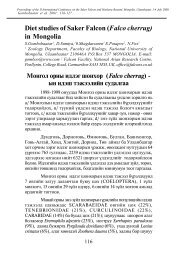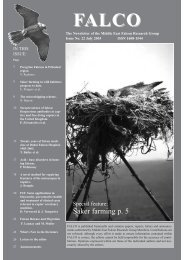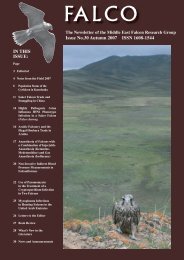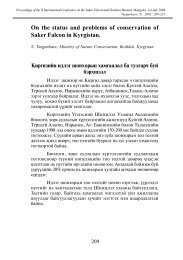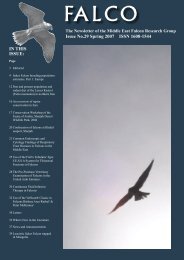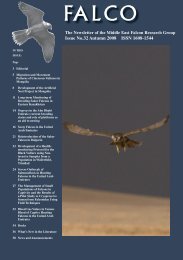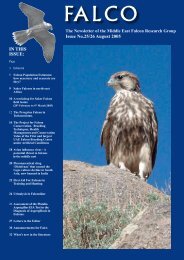falco - International Wildlife Consultants Ltd.
falco - International Wildlife Consultants Ltd.
falco - International Wildlife Consultants Ltd.
You also want an ePaper? Increase the reach of your titles
YUMPU automatically turns print PDFs into web optimized ePapers that Google loves.
Simple molecular methods for sexing birds1 Centre d’Ecologie Fonctionelle and Evolutive,UPR 9056 CNRS, 1919 Route de Mende, F-34293, Montpellier CEDEX 5, France. Email:gobiology@yahoo.com2 DEEB, Graham Kerr Building, Glasgow University,Glasgow G12 8QQ, U.K.A recent article in Falco documented the problem of correctlyidentifying the sex of birds where it was not possibleto do so from physiological appearance (D’Aloia 2002).Molecular sexing techniques were applied to blood samplestaken from pale chanting goshawks Melierax [canorus]canorus to determine the sex of birds. Although manyraptors can be sexed visually by reversed size dimorphism,this is not always conclusive, especially with young birds.In the case of the goshawks it was desirable to determinethe sex of all the birds so that they could be relocatedin pairs, and positive identification of sex is of obviousimportance for creating potentialbreeding pairs. It may also behelpful in speeding up trade ofbirds so they can settle into newhomes quicker, and when caringfor birds, when one sex may beparticularly susceptible to diseaseor stress. For veterinarians, scientistsand ecologists, identifyingsex is necessary to monitor sexdifferences in development. Forbreeders it can be useful to recordthe sex of nestlings hatched byfemales, to create family treesrecording the success of pairs andtheir young (see also Griffiths 2000a).The last ten years has seen the development of moleculartechniques to allow sexing of birds from DNA samples, sothat invasive methods such as laparotomy and laparoscopy,or expensive and time-consuming cytological sex identificationare becoming obsolete. Sexing from DNA requiresonly a tiny (2-10ml) amount of blood (e.g. Griffiths et al.1998, Kahn et al. 1998) or feathers (Griffiths and Tiwari1995), which appeals to conservationists, breeders and scientistsalike. Furthermore, one quick and simple methodhas been developed which can be applied universally to allbirds excepting ratites. As it is simpler, more efficient, andless expensive than other molecular methods, we explainits functioning here.Molecular sexing methods rely on isolating and identifyingdifferent sized fragments of DNA found in male andfemale birds. The avian genome (see glossary for scientificterms) has a set number of chromosome pairs calledautosomes; for each pair, one is derived from the motherand one from the father. Two other chromosomes, thesex chromosomes, also exist and are derived in a similarmanner. These ‘Z’ and ‘W’ chromosomes determine thesex of the bird, as females have a Z and a W chromosomebut males have two copies of the Z. This scheme is called‘female heterogamety’ because female birds have two differentsex chromosomes.Fragments of DNA from the Z and W chromosome canbe identified from a blood sample, so allowing us todetermine a bird’s sex. A method called PCR is used toidentify a specific piece of a gene, the CHD1 gene, foundon the sex chromosomes. This gene is highly conserved:homologous have been found in mice (Delmas et al. 1993),humans, Drosophila and yeast (Woodage et al. 1997). Itis because of this that the sexing test can be applied to allbirds (Griffiths et al. 1998), as all bird species contain theCHD1 gene (although there have been problems sexingratites).CHD1, like all genes, is made up of ‘exons’ which arefunctional pieces of DNA and consequently whosesequence (form) is highly conserved,and ‘introns’ - DNA withno purpose. In the sexing PCR,a pair of primers (short strands ofDNA) identify the CHD1-W geneon the W chromosome and theCHD1-Z gene on the Z chromosome.The chemical propertiesof DNA allow these primers tomake vast numbers of copies of aspecific fragment of DNA withinthese genes. The primers havebeen designed especially to locatethis exon region and amplify DNAacross an intron. The intron sizevaries between the CHD1-W and CHD1-Z gene and consequentlythe products of the PCR are two different sizedfragments. These fragments can be visualised by standardDNA visualisation techniques that allows discriminationof DNA fragments by size (see box 1). The result is thatfemales have two bands but males only one. An advantageof this test is that it amplifies both CHD1-W and CHD1-Z, which allows positive identification of both sexes. (Ifa PCR amplified only CHD1-W it would be impossibleto designate a null result as a true male or simply a failedPCR reaction).Currently there are three tests designed to identify sexusing this method (see also Grifiths 2000b), two whichamplify the same intron (Griffiths et al. 1998, Kahn et al.1998) and another which amplifies a different intron stillon the CHD1 gene (Fridolfsson and Ellegren 1999). Table1 gives primer sequences and PCR conditions for reactions.The test used by D’Aloia (2002 and also D’Aloiaand Eastham 2000) functions in a similar way, but requiresDNA cutting with a restriction enzyme after PCR amplification,necessitating the identification of a suitable enzymeand adding extra work, time, expense and opportunity for16



